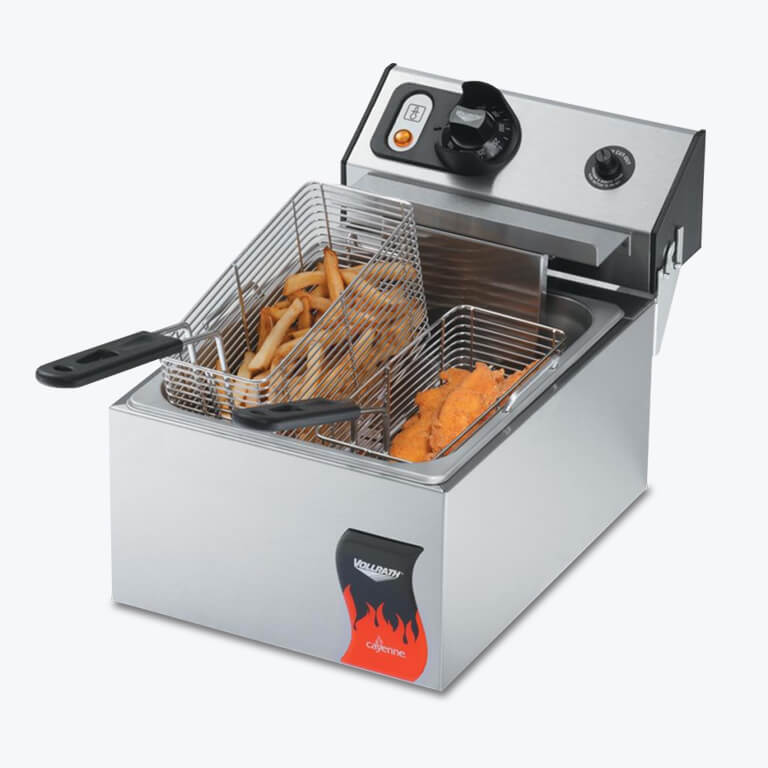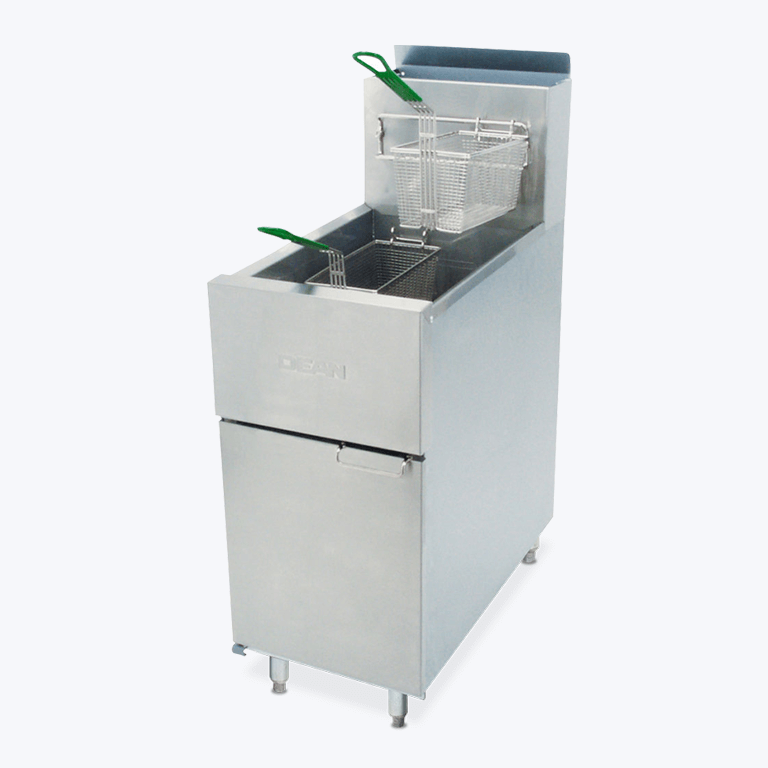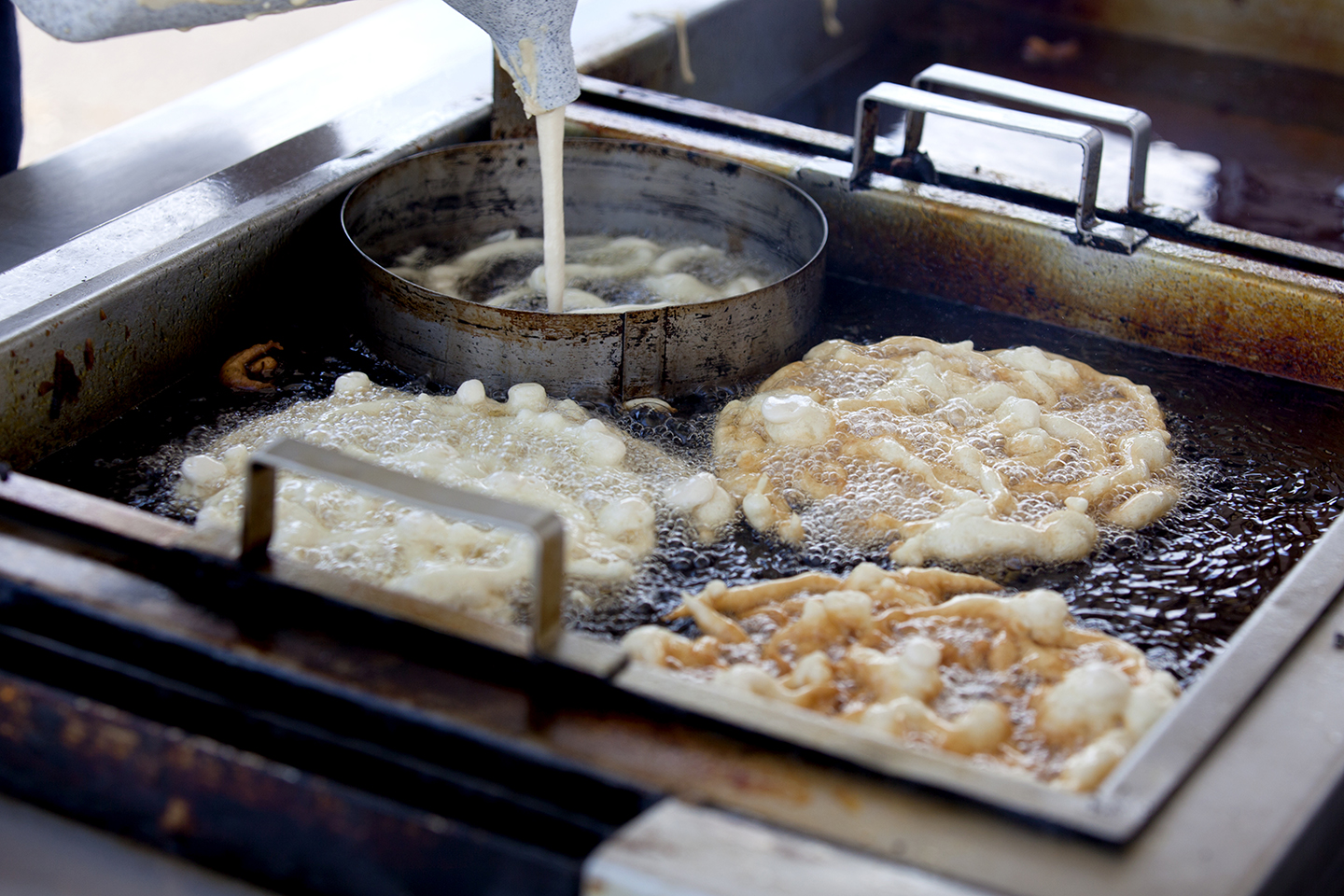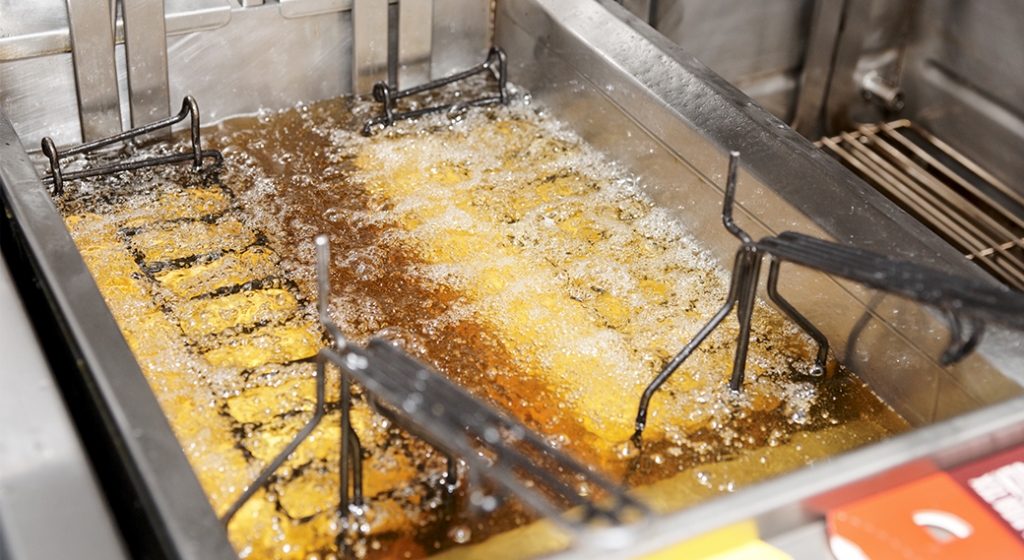Before we get started in discussing what type of commercial fryer you need, we’d like to suggest our previous post on how to choose the best-sized fryer for your business (in terms of oil capacity). If you haven’t had the chance to read it, I’d certainly recommend you begin there. If you already know what size fryer you need, let’s jump into it!
Commercial fryers come in many shapes, sizes and use different types of fuel. This article will help you determine which type of fryer and fuel type will serve you the best.
First, you’ll need to choose between one of 3 primary fryer types: countertop fryers, floor-model deep fryers and specialty fryers. Second, you’ll need to choose between 3 fuel types: natural gas, propane and electric. Last, you’ll choose between the following burner options: tube, open pot, flat-bottom and ribbon.
Step 1. Deciding Which Type of Commercial Fryer You Need
Before you dive into the details of purchasing a commercial fryer, you will need to decide on the correct commercial fryer type for your application or business. Your options may be limited based on your location. But it is good to understand all the options to make the best choice.
Countertop Commercial Fryers
Countertop Fryers are great for frying limited quantities of smaller food items such as french fries, onion rings or small orders of chicken wings. Commercial countertop fryers can frequently be found in locations that have limited floor space and often play a support-role in restaurant kitchens. The most significant issue cooks will encounter when using countertop fryers is recovery rate. Many countertop fryers run on electricity and the oil heated with an electric element in a countertop fryer cannot recover and be ready for the next basket of food as quickly as a gas-heated deep fryer.
If you have a small diner or food truck, you may be starting with a countertop fryer as your primary piece of commercial frying cooking equipment. If you absolutely need to use a countertop fryer as your primary fryer, you can purchase a 15 to 30 lb countertop unit that is fueled by natural gas or propane. This type of gas-fueled countertop, has a quicker recovery rate than that of its electric counterparts.

Shop Countertop Fryers »
Floor-Model Commercial Fryers
Floor Fryers can also handle smaller sized food items such as fries and onion rings, however their ability to recover quickly and maintain consistent temperatures tends to make them far more superior at cooking pieces of chicken and thicker pieces of meat or food product. Restaurant deep fryers can produce more servings per hour and recover quicker after frying larger chicken pieces.
Commercial deep fryers are one of the work horses of your restaurant kitchen. If you serve fried chicken, you probably have two of them. Although they manufacturer electric floor fryers, if you have a fuel source available such as natural gas or propane, it would be best to take advantage of them. Gas fryers produce much higher BTU’s per hour, allowing for your oil to heat up and maintain its cooking temperatures.
A final but important consideration when choosing a floor-model fryer is the need for hood ventilation. Most larger capacity fryers will require a full hood with fire suppression system. In some physical spaces, this may be impossible to accommodate. It is imperative that you check your local ordinances and get expert advice when attempting to install a floor fryer for the first time.

Shop Floor Fryers »
Specialty-Use Commercial Fryers
Specialty Fryers are often used in bakeries, at fairs and concession stands across a variety of food service venues. Funnel cakes, corn dogs, and donuts are all very common types of foods that are easier to fry and serve using specialty fryers engineered by use-case. Funnel fryers tend to be wide and shallow, whereas corn dog fryers will be designed or have inserts to allow a bit of the corn-dog handle to stick out of the oil for easier serving.
A lot of specialty fryers run on electricity as they are not trying to cook fish or chicken to safe temperatures. In addition, due to the nature of the ingredients, pastries and corn dogs don’t pull as much heat out of the oil as cold chicken or frozen fries. This helps your specialty fryer recover quicker. This makes it easier for your funnel cakes, corn dogs and pastries to have the texture and crispiness your patrons expect.

Fryer Type Comparison Chart
| Commercial Fryer Type | Pros | Cons |
|---|---|---|
| Countertop Fryer | Takes up less space Great for low volume frying Mobile, Portable | May have trouble frying whole chicken pieces Difficulty meeting higher volume demands Slower oil heat recovery in between batches |
| Floor Fryer | Quicker Recovery Capable of higher output Can deep fry larger food items | Larger footprint in your kitchen May require a hood Not ideal for frequent transporting |
| Specialty Fryer | Designed for specialty fried foods Improves serving efficiencey Great for donuts, funnel cakes and corn dogs | Decreased versatility Generally designed for only 1 or 2 food types Can't fry multiple food types simultaneously |
Step 2. Decide Which Fuel Source Meets Your Needs
Fuel type is probably the most critical decision you will make in selecting a commercial fryer. Again, your choices may be limited by your location, your business type or the application for which you will be using the commercial fryer.
Natural Gas
Natural gas is the most common fuel source for restaurants, bars and venues that have a significant amount of traffic. High traffic restaurants usually need one or more large floor fryers that can recover heat quickly in-between batches of food. Natural gas outputs a high amount of heat (BTUs) that absorbs into the oil via submerged tubes or indirectly as with an open pot fryer. Natural gas also heats your oil more quickly and maintains cooking temperatures far better than electric models.
The most common issue in using natural gas as your fuel source is that you must have access to a hardline. Natural gas is not portable like liquid propane and it may not be present in your building by default like electricity. You must have a natural gas line at your venue to take advantage of this fuel source. Although natural gas lines are common in the city, food-service venues outside the city may have increasingly limited access as their location becomes more rural.
Learn more about natural gas at the US Energy Information’s website
Liquid Propane
Liquid Propane (or simply, “Propane”) provides much of the same advantages as natural gas, with the distinct advantage of being portable. Even the most rural venues can be cooking with gas thanks to the ability to have liquid propane delivered just about anywhere. Food trucks with high-output especially benefit from this versatile fuel type.
If you have a natural gas fryer, no problem. Most commercial fryers can be converted from one gas type to another with a conversion kit (this should only be done by a professional installer). Pro Tip: If you use propane in your food truck, most cities will require you use a quick-disconnect hose!
The only downside to propane, is that it often has a higher cost associated with it than natural gas. And don’t forget that it’s important to always be aware of your reserve fuel-levels. This is especially important during holidays or long stretches of high-traffic business (such as in the summer and fall).
Electricity
Electricity powered commercial fryers are most commonly found in countertop fryer types. Countertop fryers have a much smaller oil capacity than their floor-standing relatives. Electricity is available nearly everywhere, making it the most versatile fuel type in terms of availability. Using electricity to heat 10-15 lbs of oil is usually sufficient for low output sides and appetizers. However electricity is the slowest method for heating oil and often requires much more recovery time in-between batches of food.
Even though commercial electric fryers are very energy-efficient, if you are cooking with over 30 lbs or more of oil, we highly recommend you cook with a gas-type fuel source. You can find electric fryers with high-capacity oil reservoirs. However, you will need to be very careful to allow enough time between batches for the oil to heat back up to safe cooking temperatures.
Fryer Fuel Type Comparison Chart
| Fuel-Type | Pros | Cons |
|---|---|---|
| Natural Gas | Heat up faster Recover lost heat quicker Maintains cooking temperatures for larger food | Must have a natural gas line available Stationary, immobile fuel source |
| Liquid Propane | Great for providing gas to Rural venues Liquid propane is portable Great for food trucks and concessions | Not as accessible in bulk within urban areas Generally costs more than Natural gas |
| Electric | Versatile, easy access fuel source Sufficient for most countertop fryers Energy efficient heat transfer | Takes longer to heat up Longer oil recovery time than gas Requires 3x more energy than gas to reach cooking temperatures |
Step 3. Decide Which Heat-Distribution System Is Best For You
When choosing a heat distribution system, you must really begin to think about the ways you will be using your commercial fryer. The products you will be serving may lead you to a natural choice, so it’s good to understand all the options.
Tubes & Baffles
Tubes and Baffles are great for frying chicken and other breaded or high-sediment foods. Commercial fryers that use tubes to heat their oil have larger cold zones which prevent sediment and debris from burning, affecting the flavor of the oil and taste of your food. Tubes and baffle fryers also have the advantage of heating oil more evenly, resulting in more consistent cooking and textures. This is accomplished by having a more efficient heat transfer as the tubes are directly submerged in the oil.
Fryers that heat with tubes can be more difficult to clean. You will want to be sure to have brushes to make cleaning in-between and under the tubes easier. Although oil in the hot zone stays at a consistent temperature, tube fryers have more oil residing in the cold zone. This is by design, however it does slightly limit the volume of food you can cook.
Open Pot
Open Pot fryers are great for low-sediment foods that create less debris. There is a larger hot zone, meaning there is also a smaller cold zone to keep sediment from burning. The heating elements are built on the outside of an open pot fryer. This reduces its heat transfer efficiency but increases capacity and makes it much easier to clean. There are no tubes or baffles to clean around.
That said, open pot fryers may take a little longer to heat up and recover in-between batches. This is because they do not have their heating tubes submerged directly in the oil. It’s also important to keep your open pot fryer clean, as there is a much smaller cold zone. This means your risk of burning sediment and tainting the taste of your fried foods is higher.
Flat Bottom
Flat Bottom fryers are popular for cooking donuts, funnel cakes and foods popular at concessions and mobile food service venues. Often, these foods wick less heat from the oil and produce very low amounts of sediment. A commercial fryer with a flat bottom is heated much like an open pot fryer. However, there is no cold zone in a flat bottom fryer. This maximizes frying capacity and is designed for the optimal cooking of pastries. The design allows them to float freely as they cook. Rather than baskets, you’ll use a flat strainer / skimmer to drop and remove your finished product.
As flat bottom fryers do not have a cold zone. Therefore it is imperative to keep them as clean as possible to prevent burning sediment. In addition, the lack of a cold zone reduces the oil life. This is because all of the oil is always heated to cooking temperatures and exposed to potential burning sediment.
Ribbon Element
Ribbon Element fryers are exclusively found in electric fryers. We’ve all seen examples of a ribbon-style oil heating element. They are not unlike the curled electric elements you’ll find on traditional, electric stovetops. In these commercial fryers, the ribbon element is connected at the bottom of the fryer. Therefore they efficiently transfer heat from the elements directly to the oil.
Electric fryers have the added benefit of adding less heat to the kitchen as more heat is directly absorbed into the oil. Although electric fryer ribbons are efficient at transferring energy, they cannot heat oil as fast as natural gas or propane. Electricity is also more expensive than natural gas or propane.
Heat Distribution Type
| Heat Distribution | Pros | Cons |
|---|---|---|
| Tubes & Baffles | Great for breaded, high-sediment foods Larger cold zones prevent sediment from burning Evenly heats the oil for consistent frying | More difficult to clean Less oil in the hot zone Tubes may require maintenance or repair |
| Open Pot | Perfect for low-sediment foods No tubes reduces cold zone, maximizing capacity Easier access for easier cleaning | Smaller cold zone for sediment Less energy efficient More risk for sediment burning if not kept clean |
| Flat Bottom | Flat-bottom design for funnel cakes and donuts Maximizes use of oil Allows food to float in the oil | No cold zone for sediment Reduced oil life Higher risk of burnt sediment tainting flavour |
| Ribbon Element | Very energy efficient Adds less heat to the kitchen Lower and easier maintenance | Electricity is often a more expensive fuel type May require a higher voltage outlet installation. Usually electric fryers take longer to heat up |
Choosing a Commercial Fryer: In Summary
Just remember, gas-fuel types produce more BTU’s of heat in a much shorter amount of time than electric. This allows for your fryer to heat its oil quickly and maintain cooking temperatures batch after batch. Natural gas is readily available in most city locations. However, you may need to rely on propane as you approach less-populated locations.
Electric fryers have superb portability and are great in assisting your larger fryers during busy times. They are also great for lower volume occasions. Just be sure that you will have enough time for the oil to recover in between customer orders. Electric fryers are also great for cooking deep-fried baked goods such as funnel cakes, donuts and corn dogs. In these cases, less heat is wicked from the oil.
Choose the best commercial fryer type, fuel source and heating elements for your venue and you’ll be sure to get the most out of your investment.




Business profound fryers are one of the work ponies of your café kitchen. On the off chance that you serve singed chicken, you most likely have two of them. In spite of the fact that they producer electric floor fryers, assuming you have a fuel source accessible, for example, petroleum gas or propane, all things considered, let’s exploit them. Gas fryers produce a lot higher BTU’s each hour, taking into account your oil to warm up and keep up with its cooking temperatures.
Commercial deep fryers are one of the work ponies of your eatery kitchen. Assuming that you serve seared chicken, you presumably have two of them. Despite the fact that they make electric floor fryers, assuming you have a fuel source accessible, for example, flammable gas or propane, all things considered, let’s exploit them. Gas fryers produce a lot higher BTUs each hour, taking into account your oil to warm up and keep up with its cooking temperatures.
When choosing the ideal fryer for my commercial kitchen, your blog proved to be of immense help to me. The blog begins by describing the various deep fryer variants before comparing and contrasting them. The site also emphasizes the significance of selecting the appropriate fuel source when purchasing a fryer. It summarizes the benefits and drawbacks of each fuel type. Finally, it discusses several heat distribution methods and how to pick the best one for one’s needs. Ultimately, investing in a high-quality commercial fryer that aligns with your business requirements will contribute to consistent food quality, customer satisfaction, and the success of your culinary venture.
4 Best Deep Fryers For Food Trucks In 2024 - Street Food Central